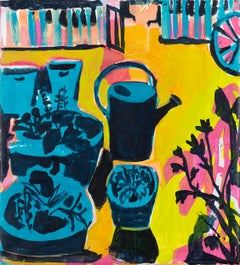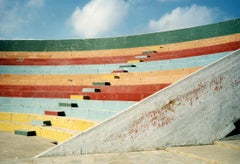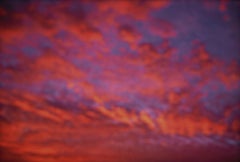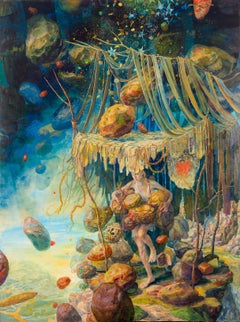Adaa Art Dealers Association Of America
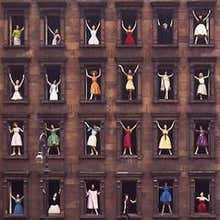
Art Dealers Association of America (ADAA)
Founded in 1962, the Art Dealers Association of America is a vetted community of more than 180 top-tier galleries across the United States. Working with these member galleries, ADAA appraisers offer assessment services for artworks spanning from the Renaissance to the present day. The ADAA also arranges public forums on important art-related topics and hosts The Art Show, presented each year at New York’s Park Avenue Armory, which stands out among art fairs for its acclaimed selection of curated booths — many of which are one-artist exhibitions.to
33
3,599
1,842
1,058
886
482
322
243
193
139
137
128
122
112
96
83
81
74
60
55
42
35
32
30
29
28
19
18
14
9
9
8
6
6
5
5
5
4
4
4
3
3
3
2
2
1
1
1
1
1
1
1
76
72
65
64
60
Folk Art Early 19thC American Sampler Wrought By "Ruthanna Stoke" Dated 1836
Located in Incline Village, NV
All original and authentic folk art American hand stitched early 19th century needlepoint sampler, wrought by "Ruthanna Stoke"; the namesake; in dark blue stitchery at the bottom cen...
Category
Early 19th Century American Folk Art Antique Adaa Art Dealers Association Of America
Materials
Tapestry
Late September
By Allison Gildersleeve
Located in Dallas, TX
Allison Gildersleeve received her BA from the College of William and Mary and her MFA from Bard College. She has exhibited across the United States and abroad, including New York Cit...
Category
2010s Contemporary Adaa Art Dealers Association Of America
Materials
Canvas, Acrylic
Ampitheater, Havana, Cuba
By David Graham
Located in New York, NY
This image, taken in Cuba during the artist's visit in 1997, was part of a collaboration with author Andrei Codrescu, and resulted in the publication of a 1999 book entitled "Ay Cuba...
Category
1990s Contemporary Adaa Art Dealers Association Of America
Materials
C Print
Pink sky from airplane
By Nan Goldin
Located in New York, NY
Nan Goldin
Pink sky from airplane
2000
Cibachrome
30 x 40 inches; 76 x 102 cm
Edition of 15
Signed, titled, dated, and numbered in ink (verso)
Available f...
Category
Early 2000s Contemporary Adaa Art Dealers Association Of America
Materials
Photographic Film, C Print
17th Century Dutch Brass Hemskirk Candlestick
Located in West Chester, PA
17th century Dutch brass Hemskirk candlestick.
Category
Early 17th Century European Antique Adaa Art Dealers Association Of America
Self-Portrait with Sanctuary
By Julie Heffernan
Located in New York, NY
Oil on canvas
Category
2010s Adaa Art Dealers Association Of America
Materials
Canvas, Oil
Venice
By Jane Peterson
Located in New York, NY
Singed (at lower left): Jane Peterson
Category
Early 20th Century American Impressionist Adaa Art Dealers Association Of America
Materials
Gouache
$60,000
"A Group Of California Indians" Wood Cut Engraving. C 1856. Very Rare. Americana
Located in Incline Village, NV
This is a very rare and important original image of early Western Americana, or more specifically, "Californiana". Mid 19th century and researched to have been engraved in 1856, it captures, in incredible detail, a group of twelve Native American Indians with a baby in a papoose, gathered together in front of their hanging tools, baskets, implements and weaponry behind them on a "tent like" backdrop. There are men, women, young, and elderly. It is a signed wood cut engraving applied in ink by well known wood cut engraver of the mid 19th century, William J. Peirce (active 1851-1879). It is in excellent all original condition with no additions, no restoration of any kind and it is housed in it's original 1 1/2" double beveled wooden birds eye maple veneered frame with a gilt 1/2" filet interior border.
"A Group Of California Indians" is engraved at the base along with a non-descript notation "For description see page 381" which appears in the margin, in addition to an illegible signature. Both these line items are also noted by the New York Public Library, where a digital example exists from the esteemed collection of "The Miriam and Ira D. Wallach Division Picture Collection", which was assembled in 1986 and recently digitalized.
The Library of Congress also memorializes this image and theirs is similarly a digital image. My example came out of the Grant Smith Collection of "Californiana", as is noted on the back of the framed engraving. He was located at Main Street in Bolinas, California (see images on the rear for provenance). Research reveals that he was a direct descendant of the coastal Miwok people who built a settlement in the Bolinas lagoon area.
The engraving is referenced in both the New York Library and The Library of Congress as "A Group of California Indians". It is one of the earlier images you will find, along with McKenny and Hall lithographed mages of Native American Indians; and because of it's subject matter and extreme rarity, "A Group Of California Indians" commands attention and interest from the Western art collectors' arena. California became a state on September 9, 1850 making this one of the earliest known images (Circa 1856) of "Californiana" and California Native American...
Category
1850s American Native American Antique Adaa Art Dealers Association Of America
Materials
Paper
Old Country Bazaar
By William S. Schwartz
Located in New York, NY
Oil on canvas, 36 x 42 in.
Signed, dated, and inscribed (at lower right): WILLIAM S. SCHWARTZ 1926; (on the back): “OLD COUNTRY BAZAAR” / BY / WILLIAM S. SCHWARTZ / 1926
RECORDED: C. H. Bonte, “122nd Annual opens at Pennsylvania Academy,” in The Philadelphia Inquirer, Jan. 30, 1927
EXHIBITED: The Art Institute of Chicago, 1926, The Thirty-Ninth Annual Exhibition of American Paintings and Sculpture, no. 174 // The Pennsylvania Academy of the Fine Arts, Philadelphia, 1927, The One-Hundred-and-Twenty Second Annual Exhibition, p. 37 no. 181 // The Chicago Culture Club...
Category
20th Century American Modern Adaa Art Dealers Association Of America
Materials
Canvas, Oil
Hommage to Kato I
By Paul Cupido
Located in Santa Monica, CA
Signed, titled, dated in ink on photographer's label.
Archival pigments on tea infused Japanese Kozo paper
Image: 17 1/2" x 11 3/4", Frame: 21" x 15"
Edition 2 of 7
Category
21st Century and Contemporary Adaa Art Dealers Association Of America
Materials
Archival Pigment
McKenney & Hall Hand Painted Lithograph "AMISKQUEW"; Rice & Clark Published 1843
By McKenney & Hall
Located in Incline Village, NV
"AMISKQUEW" "A Menominie Warrior", as stated on the lithograph, is a hand-painted color engraving on paper depicting a Native American Indian whose portrait was painted by Charles Bi...
Category
1840s American Native American Antique Adaa Art Dealers Association Of America
Materials
Paper
Girl in Decorative Wrap
By Winold Reiss
Located in New York, NY
Winold Reiss (1886-1953), who scholars increasingly recognize as a pivotal figure in early 20th-century American art, is known for his evocative portraits that capture the spirit and...
Category
20th Century American Modern Adaa Art Dealers Association Of America
Materials
Mixed Media, Board
Saving Gaia III
By Deborah Ballard
Located in Dallas, TX
Deborah Ballard is best known for conceiving of figures and groupings of figures who relate to one another (and the viewer) through their body language, relationships and dialogue. S...
Category
21st Century and Contemporary Contemporary Adaa Art Dealers Association Of America
Materials
Bronze
Autumn Roses
By Stone Roberts
Located in New York, NY
Stone’s luminous still lifes, private interiors, and large-scale panoramas of figures in motion invite us to look—and then look some more—and relish in the sensuality of the three di...
Category
Early 2000s Contemporary Adaa Art Dealers Association Of America
Materials
Linen, Oil
AI WEI WEI
By Hugo Tillman
Located in New York, NY
photograph
Category
21st Century and Contemporary Contemporary Adaa Art Dealers Association Of America
Offering: Grapes & Fig
By David Ligare
Located in New York, NY
David Ligare (b. 1945)
Contemporary American Painter
"Offering: Grapes & Fig," 2023
Oil on canvas, 20 x 24 in.
Signed and dated (at lower right): L; (on verso): Ligare / 2023
Category
21st Century and Contemporary Contemporary Adaa Art Dealers Association Of America
Materials
Oil, Canvas
Floating Bridge
By Ori Gersht
Located in New York, NY
From the series Floating World
Category
2010s Adaa Art Dealers Association Of America
Materials
Archival Pigment
Pyhäjärvi, Finland (Horse & Barn)
By Pentti Sammallahti
Located in Santa Monica, CA
Pentti Sammallahti
Pyhäjärvi, Finland (Horse & Barn)
1982
Gelatin Silver print
Category
20th Century Adaa Art Dealers Association Of America
Materials
Silver Gelatin
"Field of Order"
By Gary Ernest Smith
Located in Scottsdale, AZ
Lauded by critics and collectors alike, the art of Gary Ernest Smith resonates in the mind and memory of contemporary America. Over the past years th...
Category
2010s Adaa Art Dealers Association Of America
Materials
Linen, Oil
Unfolding Temporal Manifestation
By Jim Woodson
Located in Dallas, TX
Short Statements on Painting by Jim Woodson (in no particular order):
Remember less, Explore More
Learn then forget, then look and discover
Move Thought into Thinking
A verb is more...
Category
2010s American Realist Adaa Art Dealers Association Of America
Materials
Canvas, Oil
Figure in Garden
By Donald S. Vogel
Located in Dallas, TX
Donald Vogel’s paintings reflect his interest in seeking beauty in life and in sharing pleasure with his viewers. Vogel entreats us to "rejoice and celebrate each new day, knowing it...
Category
1980s American Impressionist Adaa Art Dealers Association Of America
Materials
Oil, Panel
Blow Up, Untitled 17
By Ori Gersht
Located in New York, NY
From the series Blow Up
Category
2010s Adaa Art Dealers Association Of America
Materials
Archival Pigment
Hong Kong, November 2016
By Luca Campigotto
Located in New York, NY
19.75 x 25 inch Canson pure pigment print, framed to 28.5 x 33.5 inches.
Edition 15. Signed, titled, dated and editioned on label verso.
Luca Campigotto uses big equipment to captur...
Category
2010s Contemporary Adaa Art Dealers Association Of America
Materials
Pigment
The Bottom of the River
By Randall Exon
Located in New York, NY
Signed and dated (at lower right): Randall Exon 2012
Category
2010s Contemporary Adaa Art Dealers Association Of America
Materials
Oil
Sparrow
By Beth Secor
Located in Houston, TX
Beth Secor
Sparrow, 2016
gouache, pencil and ink on paper
24-3/4 x 24-3/4 inches
Category
2010s Realist Adaa Art Dealers Association Of America
Materials
Gouache, Pencil
$6,000
Art Nouveau (7) Piece Sterling Silver Vanity "Necessaire" Ensemble Circa 1894
Located in Incline Village, NV
Fabulous hard to find late 19th century Art Nouveau ensemble of seven marked sterling silver vanity items to decorate and utilize for the commode; consisting of;
1) Matching hallmar...
Category
1890s English Art Nouveau Antique Adaa Art Dealers Association Of America
Materials
Sterling Silver
Joyce Ann
By Otis Huband
Located in Dallas, TX
Born in 1933, Otis Huband declared his intention to be an artist at age 6. He earned his BFA and MFA at Richmond Professional Institute of the College of William & Mary, now Virginia...
Category
2010s Abstract Adaa Art Dealers Association Of America
Materials
Canvas, Oil
A Step Up
By William Wegman
Located in New York, NY
An original photograph from the artist's "Cubism and other Isms" series in which brightly painted geometric cubes are arranged in sculptural configuration...
Category
2010s Contemporary Adaa Art Dealers Association Of America
Materials
Archival Pigment
Self-Portrait as Mad Queen
By Julie Heffernan
Located in New York, NY
Oil on canvas
Category
2010s Abstract Adaa Art Dealers Association Of America
Materials
Canvas, Oil
Old Cottonwood
By Brian Cobble
Located in Dallas, TX
Brian Cobble’s landscapes tend to particularly focus on the interplay of man and his surroundings, whether natural or built. A signature attention to the liminal aspects of a scene, ...
Category
21st Century and Contemporary Contemporary Adaa Art Dealers Association Of America
Materials
Etching
Art Deco Ladies Traveling Necessaire Ensemble, American, circa 1925
Located in Incline Village, NV
Art Deco ladies traveling necessaire ensemble consisting of 13 implements for grooming, contained in a hard cardboard green branch decorated traveling case. The grooming implements a...
Category
1920s American Art Deco Vintage Adaa Art Dealers Association Of America
Materials
Resin, Bakelite
The Intruder
By Arthur Fitzwilliam Tait
Located in New York, NY
Arthur Fitzwilliam Tait was born at Livesey Hall, near Liverpool, England, and began his career as a clerk at the gallery of Agnew & Zanetti’s Repository of Arts in Manchester. While...
Category
19th Century American Realist Adaa Art Dealers Association Of America
Materials
Oil, Wood Panel
Vintage "Barnacle Bill" Tin Windup Toy by The Chein Company, N.Y.C Circa 1930's
By J. Chein & Co.
Located in Incline Village, NV
"Barnacle Bill" was a very popular cartoon character for whom this toy was named after and was made in the 1930's by the J. Chein Toy Company of New York City. There is some evidence...
Category
1930s American Folk Art Vintage Adaa Art Dealers Association Of America
Materials
Tin
Walnut Hepplewhite One Drawer Stand
Located in West Chester, PA
Highly figured top, unusual reeded drawer, splayed legs. Delaware Valley.
Category
18th Century American Hepplewhite Antique Adaa Art Dealers Association Of America
Materials
Walnut
Still Life with Apples and Basket
By David Ligare
Located in New York, NY
Signed and dated (at lower right): L; (on verso)" D. Ligare / 2014
Category
2010s Contemporary Adaa Art Dealers Association Of America
Materials
Canvas, Oil
Still Life
By Pierre Bisiaux
Located in Dallas, TX
Signed "P. Bisiaux" at lower right
The overall dimensions, including the frame, are 29 x 34 7/8 inches
Category
Mid-20th Century Modern Adaa Art Dealers Association Of America
Materials
Canvas, Oil
Pair of Mahogany Chippendale Side Chairs
Located in West Chester, PA
Gothic splats, slip seats, cabriole legs terminating in claw and ball feet. Philadelphia. 1775.
Category
18th Century American Chippendale Antique Adaa Art Dealers Association Of America
Materials
Mahogany
$10,000 / set
The Circle is Cast, We Are Between the Worlds
By Angela Fraleigh
Located in New York, NY
In Angela Fraleigh’s dynamic paintings, female subjects culled from art history become active protagonists in newly imagined spaces. In their original contexts, these figures were largely painted as docile objects for the male gaze...
Category
2010s Adaa Art Dealers Association Of America
Materials
Oil, Acrylic
Still Life with Polykleitian Head and Candles (Idea)
By David Ligare
Located in New York, NY
Signed and dated (at lower right): L; (on verso): D. Ligare / 2018
Category
2010s Contemporary Adaa Art Dealers Association Of America
Materials
Canvas, Oil
Why Do I Love You? Louis Armstrong at 14, 000 feet over Africa, May 1956
By Larry Burrows
Located in New York, NY
A 16 x 20 inch gelatin silver print, with image size of 12 x 17.75 inches. Printed in 2004. "Larry Burrows Collection" and copyright stamps on verso.
Larry Burrows career as a LIFE ...
Category
1950s Adaa Art Dealers Association Of America
Materials
Silver Gelatin
"Dutch Boy" Themed Chocolate Mold Pattern Circa 1915, Belgium
Located in Incline Village, NV
Made circa 1915, this hammered tin mold is unmarked but probably was made in Belgium vis a vis the "Dutch Boy" theme. This two part chocolate mold pattern wa...
Category
1910s Belgian Folk Art Vintage Adaa Art Dealers Association Of America
Materials
Metal
North Shore Aquatics Club
By Neal Slavin
Located in New York, NY
Neal Slavin began photographing group portraits of organizations of people in the early 1970s, and it became a career-long passion. Synchronized swimmers are no doubt among one of th...
Category
1980s Adaa Art Dealers Association Of America
Materials
Archival Pigment
Two Wood Ducks on a Flowering Branch
By Joseph Stella
Located in New York, NY
Joseph Stella was a visionary artist who painted what he saw, an idiosyncratic and individual experience of his time and place. Stella arrived in New York in 1896, part of a wave of Italian immigrants from poverty-stricken Southern Italy. But Stella was not a child of poverty. His father was a notary and respected citizen in Muro Locano, a small town in the southern Appenines. The five Stella brothers were all properly educated in Naples. Stella’s older brother, Antonio, was the first of the family to come to America. Antonio Stella trained as a physician in Italy, and was a successful and respected doctor in the Italian community centered in Greenwich Village. He sponsored and supported his younger brother, Joseph, first sending him to medical school in New York, then to study pharmacology, and then sustaining him through the early days of his artistic career. Antonio Stella specialized in the treatment of tuberculosis and was active in social reform circles. His connections were instrumental in Joseph Stella’s early commissions for illustrations in reform journals.
Joseph Stella, from the beginning, was an outsider. He was of the Italian-American community, but did not share its overwhelming poverty and general lack of education. He went back to Italy on several occasions, but was no longer an Italian. His art incorporated many influences. At various times his work echoed the concerns and techniques of the so-called Ashcan School, of New York Dada, of Futurism and, of Cubism, among others. These are all legitimate influences, but Stella never totally committed himself to any group. He was a convivial, but ultimately solitary figure, with a lifelong mistrust of any authority external to his own personal mandate. He was in Europe during the time that Alfred Stieglitz established his 291 Gallery. When Stella returned he joined the international coterie of artists who gathered at the West Side apartment of the art patron Conrad Arensberg. It was here that Stella became close friends with Marcel Duchamp.
Stella was nineteen when he arrived in America and studied in the early years of the century at the Art Students League, and with William Merritt Chase, under whose tutelage he received rigorous training as a draftsman. His love of line, and his mastery of its techniques, is apparent early in his career in the illustrations he made for various social reform journals. Stella, whose later work as a colorist is breathtakingly lush, never felt obliged to choose between line and color. He drew throughout his career, and unlike other modernists, whose work evolved inexorably to more and more abstract form, Stella freely reverted to earlier realist modes of representation whenever it suited him. This was because, in fact, his “realist” work was not “true to nature,” but true to Stella’s own unique interpretation.
Stella began to draw flowers, vegetables, butterflies, and birds in 1919, after he had finished the Brooklyn Bridge series of paintings, which are probably his best-known works. These drawings of flora and fauna were initially coincidental with his fantastical, nostalgic and spiritual vision of his native Italy which he called Tree of My Life (Mr. and Mrs. Barney A. Ebsworth Foundation and Windsor, Inc., St. Louis, illus. in Barbara Haskell, Joseph Stella, exh. cat. [New York: Whitney Museum of American Art, 1994], p. 111 no. 133).
Two Wood Ducks...
Category
20th Century American Modern Adaa Art Dealers Association Of America
Materials
Color Pencil
Like Ice in the Clouds (Japan) No. 71
By Simone Rosenbauer
Located in New York, NY
15 x 15 archival pigment print, edition 8.
Signed, titled, dated and editioned on frame label provided.
In this latest body of work, Simone Rosenbauer continues her series "Like Ic...
Category
2010s Contemporary Adaa Art Dealers Association Of America
Materials
Archival Pigment
Time Together with Time to Spare
Located in Houston, TX
David Aylsworth (born 1966, Tiffin, OH) earned a BFA from Kent State University in 1989 and was an artist resident at the Core Program, Museum of Fine Arts, Houston, from 1989-1991. ...
Category
21st Century and Contemporary Adaa Art Dealers Association Of America
Materials
Canvas, Oil
Hydrangeas and Other Garden Flowers
By John Ross Key
Located in New York, NY
Signed (at lower right): John Ross Key 1882
Category
Late 19th Century American Realist Adaa Art Dealers Association Of America
Materials
Canvas, Oil
Harney County, Oregon
By Robert Adams
Located in New York, NY
Robert Adams
Harney County, Oregon
2005
Set of four photogravures
Each image: 19 7/8 x 15 5/8 inches; 51 x 40 cm
Each frame: 29 x 25 inches; 74 x 64 cm
Edition of 30
Each signed, ...
Category
Early 2000s Contemporary Adaa Art Dealers Association Of America
Materials
Photogravure
Human and Animal Locomotion. Plate 631.
By Eadweard Muybridge
Located in New York, NY
Human and Animal Locomotion. Plate 631.
Gallop; saddle; thoroughbred bay horse Bouquet
14 x 20 inch original vintage collotype print from 1887
Image size 7 x 16 inches
Muybridge copy...
Category
1880s Adaa Art Dealers Association Of America
Materials
Photographic Paper
Duck and Dolphin
By Francesca Fuchs
Located in Houston, TX
Francesca Fuchs
Duck and Dolphin, 2018
acrylic on canvas over board
30 x 41 1/2 in (76.2 x 105.4 cm)
This work is part of a series currently on view...
Category
21st Century and Contemporary Contemporary Adaa Art Dealers Association Of America
Materials
Canvas, Acrylic, Board
Mechanical Bank "Fishing Bears" Battery Operated with Original Box, circa 1950s
Located in Incline Village, NV
This is a later (1950's), albeit often overlooked and important mechanical bank that is quite rare, and highly sought after by collectors. Iconic bank collector F.H. Griffith wrote a...
Category
1950s Japanese Folk Art Vintage Adaa Art Dealers Association Of America
Materials
Tin
New York from Hoboken
By William Rickarby Miller
Located in New York, NY
Signed (at lower left): W.R. Miller/ 1851
Category
Mid-19th Century American Realist Adaa Art Dealers Association Of America
Materials
Canvas, Oil
Cap de Coeur
By Paul Cupido
Located in Santa Monica, CA
Signed, titled, numbered and dated in ink on photographers label.
Archival pigments on Kozo paper
Image/Sheet: 12" x 9"
Edition of 10
Category
21st Century and Contemporary Adaa Art Dealers Association Of America
Materials
Archival Pigment
Afternoon
By Jim Richard
Located in Houston, TX
Jim Richard
Afternoon, 2017
Flashe on canvas
41 1/2 x 56 in (105.4 x 142.2 cm)
This work is on view as part of the exhibition "I Know a Place", through July 7, 2018
For his fourth...
Category
21st Century and Contemporary Contemporary Adaa Art Dealers Association Of America
Materials
Canvas, Acrylic
$14,500
That Yard
By Jim Richard
Located in Houston, TX
Jim Richard
That Yard, 2017
Flashe on canvas
42 x 56 in (106.7 x 142.2 cm)
This work is on view as part of the exhibition "I Know a Place", through July 7, 2018
For his fourth sol...
Category
21st Century and Contemporary Contemporary Adaa Art Dealers Association Of America
Materials
Canvas, Acrylic
$14,500
Human and Animal Locomotion. Plate 646.
By Eadweard Muybridge
Located in New York, NY
Human and Animal Locomotion. Plate 646.
Jumping a hurdle; saddle; rider, 105, nude; gray mare Pandora
14 x 20 inch original vintage collotype print from 1887
Image size 6 1/2 x 17 in...
Category
1880s Adaa Art Dealers Association Of America
Materials
Photographic Paper
Untitled
By Charles Houghton Howard
Located in New York, NY
Charles Houghton Howard was born in Montclair, New Jersey, the third of five children in a cultured and educated family with roots going back to the Massachusetts Bay colony. His father, John Galen Howard, was an architect who had trained at M.I.T. and the École des Beaux-Arts in Paris and apprenticed in Boston with Henry Hobson Richardson. In New York, the elder Howard worked for McKim, Mead and White before establishing a successful private practice. Mary Robertson Bradbury Howard, Charles’s mother, had studied art before her marriage. John Galen Howard moved his household to California in 1902 to assume the position of supervising architect of the new University of California campus at Berkeley and to serve as Professor of Architecture and the first Dean of the School of Architecture (established in 1903). The four Howard boys grew up to be artists and all married artists, leaving a combined family legacy of art making in the San Francisco Bay area that endures to this day, most notably in design, murals, and reliefs at the Coit Tower and in buildings on the Berkeley campus.
Charles Howard graduated from the University of California at Berkeley in 1921 as a journalism major and pursued graduate studies in English at Harvard and Columbia Universities before embarking on a two-year trip to Europe. Howard went to Europe as a would-be writer. But a near-religious experience, seeing a picture by Giorgione in a remote town outside of Venice, proved a life-altering epiphany. In his own words, “I cut the tour at once and hurried immediately back to Paris, to begin painting. I have been painting whenever I could ever since” (Charles Howard, “What Concerns Me,” Magazine of Art 39 [February 1946], p. 63). Giorgione’s achievement, in utilizing a structured and rational visual language of art to convey high emotion on canvas, instantly convinced Howard that painting, and not literature, offered the best vehicle to express what he wanted to say. Howard returned to the United States in 1925, confirmed in his intent to become an artist.
Howard settled in New York and supported himself as a painter in the decorating workshop of Louis Bouché and Rudolph Guertler, where he specialized in mural painting. Devoting spare time to his own work, he lived in Greenwich Village and immersed himself in the downtown avant-garde cultural milieu. The late 1920s and early 1930s were the years of Howard’s art apprenticeship. He never pursued formal art instruction, but his keen eye, depth of feeling, and intense commitment to the process of art making, allowed him to assimilate elements of painting intuitively from the wide variety of art that interested him. He found inspiration in the modernist movements of the day, both for their adherence to abstract formal qualities and for the cosmopolitan, international nature of the movements themselves. Influenced deeply by Surrealism, Howard was part of a group of American and European Surrealists clustered around Julien Levy. Levy opened his eponymously-named gallery in 1931, and rose to fame in January 1932, when he organized and hosted Surrealisme, the first ever exhibition of Surrealism in America, which included one work by Howard. Levy remained the preeminent force in advocating for Surrealism in America until he closed his gallery in 1949. Howard’s association with Levy in the early 1930s confirms the artist’s place among the avant-garde community in New York at that time.
In 1933, Howard left New York for London. It is likely that among the factors that led to the move were Howard’s desire to be a part of an international art community, as well as his marriage to English artist, Madge Knight...
Category
20th Century American Modern Adaa Art Dealers Association Of America
Materials
Paper, Gouache, Graphite
Like Ice in the Clouds (Japan) No. 117
By Simone Rosenbauer
Located in New York, NY
15 x 15 archival pigment print, framed, edition 8.
Signed, titled, dated and editioned on frame label provided.
In this latest body of work, Simone Rosenbauer continues her series "...
Category
2010s Contemporary Adaa Art Dealers Association Of America
Materials
Archival Pigment
Vintage "Happy Hooligan" "Rolly Dolly" By Schoenhut Toy Co. German, Circa 1901
By Schoenhut
Located in Incline Village, NV
Proverbial comic character toy of the era "Happy Hooligan" was recreated by the Schoenhut Toy Company at the turn of the century calling them a "Rolly Do...
Category
Early 1900s German Folk Art Antique Adaa Art Dealers Association Of America
Materials
Composition
Self-Portrait (Lion Birth)
By Julie Heffernan
Located in New York, NY
Oil on canvas
Category
2010s Abstract Adaa Art Dealers Association Of America
Materials
Canvas, Oil
Vintage Cast Iron Doorstop "Carpenter" American, circa 1910
Located in Incline Village, NV
From the Alice in Wonderland series, this full figured American cast iron doorstop features the "Carpenter" and he is sitting down with hands on knees, a ruler in his back pocket, often referred to as "taking a break". Unknown manufacture albeit the number "665" is stamped at the lower part of the hollowed out interior (see image. The doorstop is completely original in excellent all original paint, with no repairs, no restoration, and no touch up paint. It is nicely painted in brown, orange, and black, with flesh tones to the face and hands. Dimensions are 5 3/4" High x 4" Deep x 3" Wide. It has quite a bit of weight to it considering it's size. Excellent age crazing and patina throughout. The doorstop is circa 1910, judging by the finish and the popularity of Alice in Wonderland in America.
The doorstop is referenced on page 200 in "The Doorstop Book" by John and Nancy Smith...
Category
1910s American Folk Art Vintage Adaa Art Dealers Association Of America
Materials
Iron

